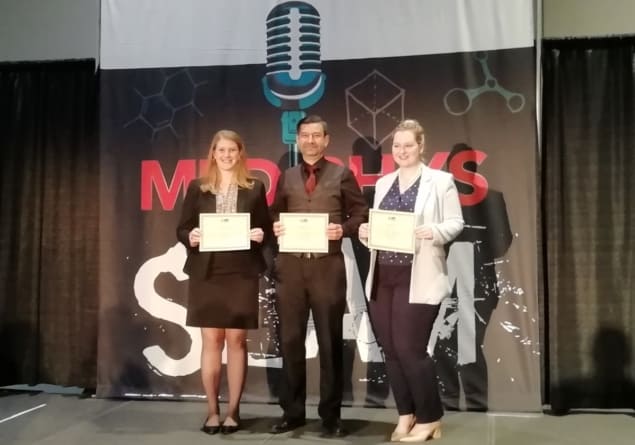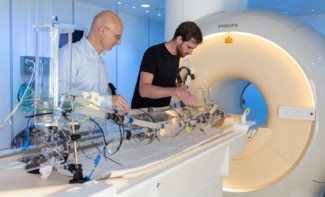
The inaugural MedPhys Slam at last year’s AAPM Annual Meeting proved such a success that the conference organizers brought it back for AAPM 2019 in San Antonio.
The MedPhys Slam is a research communication competition in which participants – PhD students, medical physics residents and postdoctoral researchers – have just three minutes and three slides with which to share the significance of their research in a compelling and coherent manner.
This year’s competition was judged by a panel of four non-medical physicists: sports broadcaster Dan Weiss, education and leadership program coordinator Amanda Gamez, meteorologist Bill Taylor and David Weiss, Dean of the Graduate School of Biomedical Sciences at UT Health San Antonio.
Eighteen competitors took part this year – all winners of their local AAPM regional chapter competitions. The speakers covered a wide range of themes, from Monte Carlo plan optimization to AI and machine learning, motion management to electronic brachytherapy, and even how to use teeth to measure dose exposure after an unplanned radiation event.
The winner was Ricardo Rademacher, a resident at Genesis Healthcare Partners, who presented a talk entitled “We wouldn’t spray paint the Mona Lisa – so why do we spray paint our patients?”.
Rademacher asked the audience to imagine trying to create the Mona Lisa with spray paint – it would be impossible to create fine details and the edges would be blurry. He compared this to the situation in radiotherapy, where the diverging X-ray beams delivered by linacs result in beam dilution and blurred edges. This, in turn, can make it difficult to deliver radiation solely to the tumour.
“If instead, we used a pencil to draw the Mona Lisa, we could create fine sharp details,” he explained. “So what if we focus the beam from the linac? With no dilution and no penumbra, we could more effectively deliver radiation to the tumour and reduce dose to healthy tissue.”
To achieve this, Rademacher is developing a compound refractive lens containing thousands of tiny drilled holes. The lens, which is currently being created and will then be tested, could be installed on existing linacs to eliminate divergence. “I look forward to future when we can treat more effectively and efficiently than ever before,” he concluded.
Salt monitor
The runner-up of the 2019 MedPhys Slam was Mychaela Coyne, a PhD Student from Purdue University, who presented “A new way to measure sodium”. Coyne explained that while many of us consume too much salt, which can lead to high blood pressure and other diseases, there is currently no clinical method available to measure sodium retained in the body.
To address this, Coyne proposes the use of in vivo neutron activation analysis to measure sodium concentrations in bone. The method works by irradiating tissue with low-energy neutrons and detecting the produced gamma rays, which provide information on the elements present in the irradiated sample.
Coyne is developing a system that measures sodium concentration in the hand, which she notes can provide information about levels in the whole body. She has used the device to show that sodium is stored in bone with a concentration related to consumption of salt. “This is the first system that can measure this directly,” she said.
People’s choice
Finally, the audience got their say, with online voting used to determine the “People’s Choice”. The winner here was Mary Peters, a graduate research assistant at MD Anderson Cancer Center. In a talk entitled “Big data for big change”, she explained that cancer patients need to begin their treatment as soon as possible, but often wait days or even weeks for treatment. Her goal is to reduce this to hours.

MedPhys Slam: fostering the art of communication
Prior to delivering radiation therapy, each patient requires a unique treatment plan. Starting from scratch for each patient makes this a time-consuming process. Peters’ proposal is to dramatically reduce waiting times by exploiting the large amount of data available from previous treatments of similar cancers.
For each patient, Peters explains, an algorithm finds similar patients in the database and uses these data to help select the best plan for the new patient. Once the algorithm is fully developed, she plans to share it with other cancer centres. “We hope to harness our experience in treating thousands of patients to help new patients,” she told the assembled delegates.



